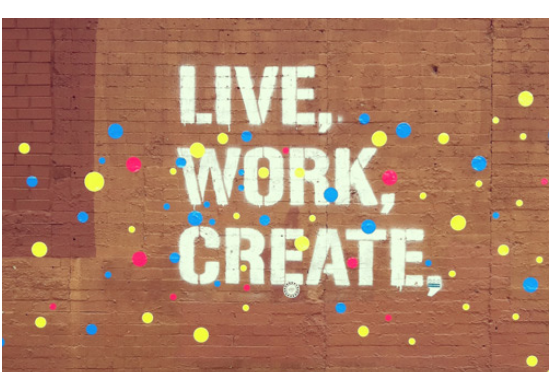Blue and Yellow Make Green!
by artfulann in Living > Education
59389 Views, 58 Favorites, 0 Comments
Blue and Yellow Make Green!

Knowing about color is a necessary task for artists. Teaching about the color wheel is one of the lessons that most art classes will study as the color wheel is an organizational tool for understanding color. This instructable will show a color wheel painted on a 48 inch round table. I am painting this table as a real life object lesson for my middle school students in my art classroom.
Free Stuff

So inspired by a pinterest photo of a table painted like a color wheel, I decided this week (school is starting next week- eek!) to start painting this table. Now because it was fairly large, I had to take it apart to fit it into my small SUV. I didn't/don't want to put it together until I get it at school as I'm going to have to transport again. So my painting happened in my messy garage. Sorry folks. This is reality.
Materials
sandpaper and elbow grease or palm sander
primer
paints: latex, acrylic, your choice
brushes
water
patience
and eventually sealer of some kind to protect all of this work from scraping and the like!
Clean, Prime, Sand and Maybe Prime Again?
- First clean your surface and dry.
- Sand the surface to roughen the surface paint and also smooth out any chipped places.
- Wipe/wash again and then dry. (yes dry again unless you live in the desert where the humidty is wicked away like money)
- Prime.
- Sand. Reprime if needed.(I did, see below.)
- Sand again to nullify all those brushstrokes.
Sidenote: I tried to revitalize some primer I had in the garage. It had gotten pretty firm. So I got out my trusty drill and paint mixer thingee and added water and and...well it sort of worked, but when I started painted I noticed some thicker chunky spots. So not really the best idea after all. I've discovered recently that you shouldn't store your used paint in your garage particularly if you live somewhere like Houston where it is really hot and humid. I've still got it out there ( the paint), mostly because I have no room for it inside without being totally tacky and using it for shelves (you know the old paint can with board shelf you had in college--oops dating myself now!) Since a good portion of the paint was given to me, if I lose it because it solidifies, I guess I haven't lost anything. Meanwhile, you environmental types like me, I've got the primer (and the second can I found in a similar condition) sitting ready to go for the hazard recycling pick up. I didn't throw it in the trashcan. Funny how paint is classified like batteries.
Design Process

Art refresher:
Pure hue (pure color, the most saturated color without anything added, or in plain language: right out of the bottle)
Shade (color with black added)
Tint (color with white added)
To come up with 12 pie shapes in a circle, well my method wasn't really exact (sorry engineers, but I'm an artist). And I didn't take pictures because...because I knew I was gonna guesstimate and it weren't gonna' be pretty. And no one would like this un-pretty guessing.
I took paper and made a 1/4 size piece pattern- I had paper that was 24 inches long. Then I folded the paper into three to have a 1/12 piece. Tip, folding into three is kind of guess work. One method is to slightly fold the first edge until what you SEE remaining looks about the same size and fold.That's what I did. And what I got was pretty close to perfect so I went with it. Another method is to hold the paper and fold without creasing into a tube/cone. When you've got something that is about the same- crease/fold away.
Then I found the center of my table and marked that. And used my pie shape wedge to mark 12 sections along the edge, using my center marking as a pivot point.
Then taking a yardstick, (because I couldn't find the 4 foot level-- where is that sucker??), I drew light pencil lines across the table, criss crossing so that I had a table divided into 12 pie slices.
Then I took string and pivoted around with the pencil tied onto the string where I wanted my circles to be for my shade, hue and tint. Not photo worthy exept the end product. I don't have a compass that large- do you? Anyway-kind of rough. But then, I'm an artist and I can get away with that kind of stuff. Because I know the secret.The secret is knowing how to deal with your mistakes!
Neutral Gray/grey- How Do You Spell That Word?

I then painted around the outer edge with gray. Why?
Grey is a neutral color. You get gray when you mix complements together (colors opposite on the color wheel or the highest contrast, like red and green, blue and orange, yellow and violet). Grey is great for giving you the best background to your colors-- it's Switzerland with a bonus: gray has no opinion. It won't favor blue over yellow. Grey will just highlight both!
There is a mid-gray shade that is called neutral by photographers. But grey is a great color. It's the new black or white? Or maybe a combination of black and white?
While painting my gray, I modified my design. (I'm allowed to do that; it is my design.) My smaller paint roller was a 4" roller. Now I had kind of measured around with my string compass a 4 inch rule. But while rolling out the paint, I realized I had another compass type measuring device. So I just used the edge of my paint roller to demarkate my first color line. I wasn't really concerned about the perfection of this line.( I'm trying to get my students away from the fear factor of perfection.) So-- if I wasn't perfect, better for their lesson to see how I overcame my imperfections. If your teacher is perfect, how will you learn?
Paint Away


Mistakes

First of all my purples (violets, same thing) aren't right. How? It's hard to describe but they're too muddy. Even the perfect hue from the tube isn't the right color. And red- violet is perfectly violent. I'm going to redo them. But I'm waiting until the students see the evidence and then I'll be able to use this as an object lesson, a real life object lesson.
It is important to see how you overcome mistakes. I need to repeat this: It is important to see how you overcome mistakes. Mistakes are your opportunity. How do you deal with mistakes?
So I'll repaint the violet and red-violet with my student support. Sometimes they give me inspiration! I'm curious about what they'll say And I can't wait for the conversation.
Not Finished Yet

Final Thoughts
